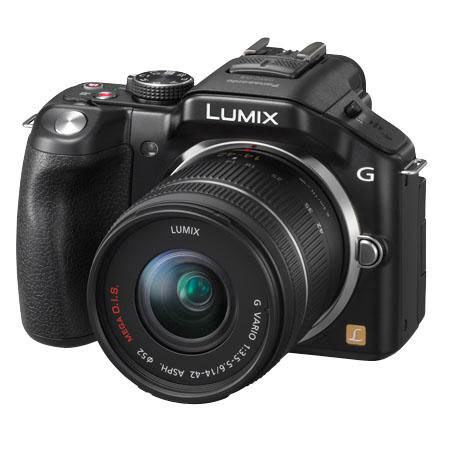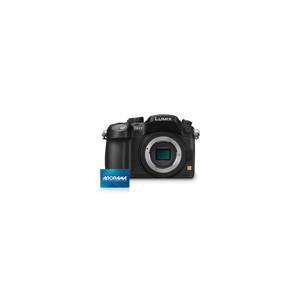Panasonic Lumix DMC-G5 16 MP Camera, Black with Lumix G Vario 14-42mm/F3.5-5.6 ASPH./MEGA O.I.S Zoom Lens $398.00
A fine camera for advanced hobbyists.
Features:
One of the newest compact system cameras (DSLM) cameras from Panasonic,
the LUMIX G5 features a newly integrated 16.05-megapixel Live MOS sensor
and redesigned Venus Engine to render clear, crisp images in both photo
and video recording. Featuring a compact, light-weight body with
built-in flash, the LUMIX G5 boasts ultra-high mobility while offering
users a powerful camera performance which achieves spectacular image
quality, realizing true-to-life photo details through excellent
resolution, image rendering and color production. When used with the
LUMIX G5, the full line of high-grade lens combines with its precision
AF (Auto Focus) to achieve high resolutions, with an optimal balance of
resolution and noise reduction to produce lifelike image rendering and
high precision auto exposure and white balance for faithful color
reproduction.
When used with the LUMIX G5, the full line of
high-grade lens combines with its precision AF (Auto Focus) to achieve
high resolutions, with an optimal balance of resolution and noise
reduction to produce lifelike image rendering and high precision auto
exposure and white balance for faithful color reproduction. A redesigned
Venus Engine features exceptionally advanced signal processing
capabilities, producing clear, crisp images in both photo and video
recording.
The 3DNR detects smooth areas or edges in photos and
adjusts the strength of noise reduction (stronger for smooth portion,
milder for edge portion) to maintain object descriptiveness. The
Multi-process NR quickly detects brightness in each part of a picture
and applies optimal noise reduction in multiple steps. The newly
incorporated HDR (High Dynamic Range) allows for several pictures
consecutively shot at different exposure levels to be overlaid,
producing a single composite picture to eliminate over-exposure or
under-exposure.
-----------------------------------------------------------
Panasonic Lumix DMC-GH3 Mirrorless Digital Camera Body Only, Black $1098.00
A top of the line pro caliber DSLR for this small format.
Features:
Panasonic is proud to introduce a new Digital Single Lens Mirrorless
Camera DMC-GH3 of its top-of-the-line GH series. The LUMIX GH3 is not
just a compact, lightweight camera. It is an attractive, top-of-the-line
mirrorless single lens system camera that is tough enough to withstand
the extreme conditions of heavy field use. In Europe and the United
States, digital SLR cameras are called DSLR and mirrorless cameras are
referred to as CSC (Compact System Cameras). Panasonic uses the term
DSLM (Digital Single Lens Mirrorless) cameras to refer to its mirrorless
models, and continues to develop attractive camera systems with
interchangeable lenses. With the introduction of the high-end LUMIX GH3,
Panasonic will be able to provide more people with the experience of
exploring the remarkable potential of the digital single lens mirrorless
camera.
The new Live MOS Sensor achieves high-resolution images with minimum noise. And the new Venus Engine attains high-speed, high-quality signal processing. These features combine to maximize shooting fun and operating ease. Another prominent feature of the LUMIX GH3 is a tough body that is rugged enough to stand up to even professional use. It features a magnesium alloy full diecast body and advanced splash / dustproof construction that was achieved by tightly sealing the sections of the camera body to enable shooting under extreme conditions. Although the LUMIX GH3 is integrating features a class above than other G Series models, it is still compact when compared with an SLR camera featuring equivalent performance and functions. The body has enabled a new control layout with three dials on the front and back as well as single-function buttons. The LUMIX GH3 allows users to capture images in extreme environments and provides superb mobility. It also records still images consecutively at a rate of about 6 fps. The LUMIX GH3 is proud to assume the role of Panasonic's flagship digital single-lens mirrorless camera.
The newly developed 16.05 effective megapixels Live MOS sensor boasts wide dynamic range and high sensitivity image recording even at ISO 12800 or ISO 25600 in extended mode. The key point here was reducing noise, for which Panasonic focused on the following three areas: (1) minimizing noise in the sensor, (2) preventing sensor noise from entering the output signal, and (3) preventing noise from entering the signal processing circuit, power supply line and grounding line. To reduce noise, it is also important to design the power supply wiring and the signal wiring connected to the engine to be as close to the same length as possible. These measures not only suppress noise but also help to improve processing speed. Standard sensitivity is from ISO 200 to ISO 12800, but the user can set sensitivity to ISO 125 or ISO 25600 by using an extension function. The LPF (Low Pass Filter) has been also newly designed to minimize generation of moire while drawing maximum resolution of the image out of the sensor.
The new Live MOS Sensor achieves high-resolution images with minimum noise. And the new Venus Engine attains high-speed, high-quality signal processing. These features combine to maximize shooting fun and operating ease. Another prominent feature of the LUMIX GH3 is a tough body that is rugged enough to stand up to even professional use. It features a magnesium alloy full diecast body and advanced splash / dustproof construction that was achieved by tightly sealing the sections of the camera body to enable shooting under extreme conditions. Although the LUMIX GH3 is integrating features a class above than other G Series models, it is still compact when compared with an SLR camera featuring equivalent performance and functions. The body has enabled a new control layout with three dials on the front and back as well as single-function buttons. The LUMIX GH3 allows users to capture images in extreme environments and provides superb mobility. It also records still images consecutively at a rate of about 6 fps. The LUMIX GH3 is proud to assume the role of Panasonic's flagship digital single-lens mirrorless camera.
The newly developed 16.05 effective megapixels Live MOS sensor boasts wide dynamic range and high sensitivity image recording even at ISO 12800 or ISO 25600 in extended mode. The key point here was reducing noise, for which Panasonic focused on the following three areas: (1) minimizing noise in the sensor, (2) preventing sensor noise from entering the output signal, and (3) preventing noise from entering the signal processing circuit, power supply line and grounding line. To reduce noise, it is also important to design the power supply wiring and the signal wiring connected to the engine to be as close to the same length as possible. These measures not only suppress noise but also help to improve processing speed. Standard sensitivity is from ISO 200 to ISO 12800, but the user can set sensitivity to ISO 125 or ISO 25600 by using an extension function. The LPF (Low Pass Filter) has been also newly designed to minimize generation of moire while drawing maximum resolution of the image out of the sensor.







